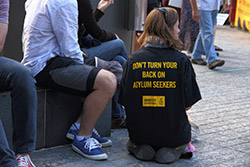
“Give me your tired, your poor,
Your huddled masses yearning to breathe free,
The wretched refuse of your teeming shore.
Send these, the homeless, tempest-tost to me,
I lift my lamp beside the golden door!”
This, according to Emma Lazarus’s famous poem “The New Colossus,” is what the Statute of Liberty cries to the world. It is a reminder that America opens its doors to the most desperate of immigrants, those whose very life is threatened if they return to their home country. In this day and age many of these immigrants are refugees seeking asylum.
A refugee is “someone who is unable or unwilling to return to and avail himself or herself of the protection of his or her country of nationality or, if stateless, country of last habitual residence because of persecution or a well-founded fear of persecution on account of race, religion, nationality, membership in a particular social group, or political opinion.”
There are actually two paths to asylum self-proclaimed refugees can take, known as affirmative and defensive asylum respectively. Which path is appropriate depends largely on the filer’s current immigration status.
Affirmative asylum is available to refugees who have been physically present in the United States for less than a year, regardless of their immigration status. An application for affirmative asylum is filed directly with U.S. Citizenship and Immigration Services (USCIS). If a self-proclaimed refugee has been physically present in the United States for more than a year, he or she can still apply for affirmative asylum if he or she can show that circumstances that materially affect his or her eligibility for asylum have changed, or that extraordinary circumstances delayed his or her filing. He or she must apply for affirmative asylum within a reasonable amount of time given the circumstances.
Defensive asylum, as the name suggests, is a defense to deportation. It is filed with the immigration judge presiding over the self-proclaimed refugee’s removal proceeding.
The key to success in both affirmative and defensive cases is proving the applicant is truly a refugee as defined above. How the evidence is presented depends on the type of asylum.
Affirmative applications for asylum are heard by USCIS Asylum Officers. The process is a non-adversarial interview. Defensive applications are heard by Immigration Judges in adversarial (court-like) proceedings.
If you are in deportation proceedings and/or believe that you may be a refugee, you should contact us now for a consultation in order for us to assist you. Franz Cobos, Esq.